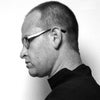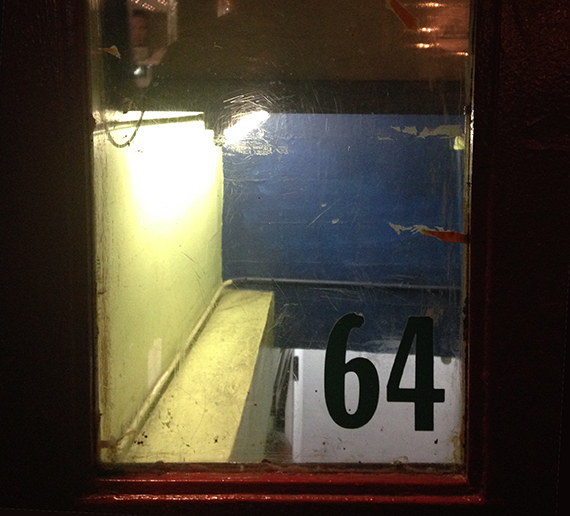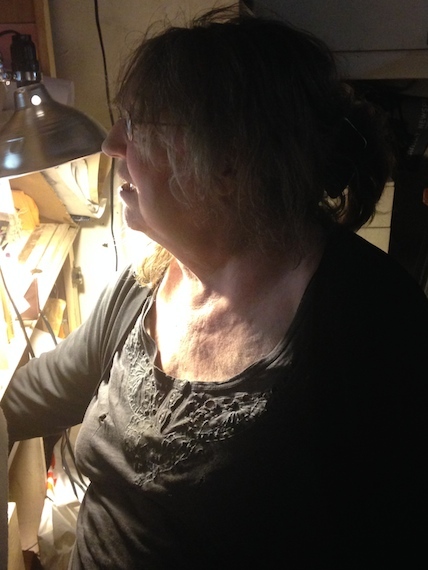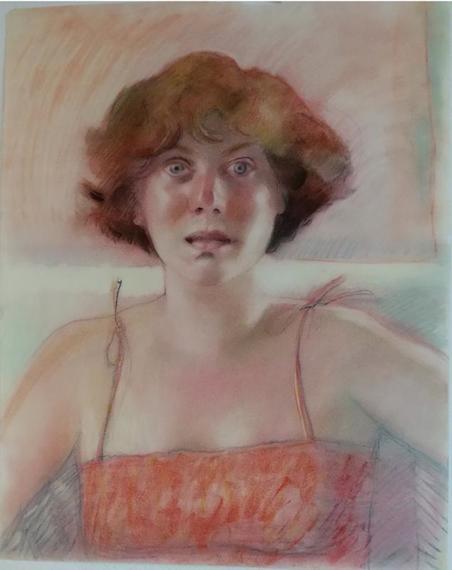Some years ago, I lived in one of those artsy little towns which freckle the South. There was a main road in this town, and off to one side of it, a fenced-off bare lot. Walking past, one would notice slow changes in the lot: the digging of a foundation, laying in of beams, the start of a building. But only one person was ever there, a sunburned guy in muddy clothes who was always lugging supplies, or operating a heavy machine, or pushing a full wheelbarrow.
This went on for a couple years, until one day there appeared, as if from nowhere, a complete, fairly large building, in glass, steel, and brick, adorned with beautiful carved wooden details. On the day it opened, we filed in, gawping at this apparition of a building. Inside were an atrium, and a balcony, and a second floor divided into studios. It turned out it was a new arts center, and that one guy we'd been seeing all that time had built it single-handed. Every day we'd seen him out there, he had patiently been building his building. He'd even carved the wooden details, and sanded and varnished them, and fitted them into place. It was both a gift to the local arts scene, and a solitary work of passion.
Naturally, I wanted to talk with him about his project. So I made my way over and started chatting. He told me about it alright - and told me and told me. He couldn't stop running his mouth. He spoke in a tone both demanding and whiny, without a single space for a listener to reply. His gaze was intense but wandering, like a frightened and angry bird. Now it would fix on you, now on something else, now on nothing at all. He stood slightly too close to you, and leaned forward at the waist.
It was a stressful and exhausting experience, spending even ten or fifteen minutes talking with this lone builder.
I don't know his name. I don't know the name of his building, or its address. If I went back to the town, I would remember how to walk you there, and we could go in, and maybe still find him around the place.
My encounter with this man made a lasting impression on me. In hindsight, I had the feeling that what I had encountered was greatness. I felt I had gotten a first-hand impression of the nature and price of greatness. I learned that greatness, at least this form of it, consisted in some way in going out, stubbornly and alone, every single day, for years and years, and continuing with a project plotted out in the misty past, and simply doing the work until the work was done. That this single-minded intensity of purpose, animating every part of a life, carries with it a terrible cost: that you lose, to some extent, your ability to be at ease with your fellow man, or even to communicate with him. That it makes you wild, and not wild in some romantic, feathered-hair sense, but wild in its harshest aspect: hard-bitten, terrified, cruel, ravenous.
I have encountered this bare human voltage only a few times in my life. Having come near to it once, it is not hard to recognize when it comes by again. In 2005, I was preparing to move to New York. I made one of my periodic visits to the city, and I was drawing at the Met, as one will. Another artist was drawing nearby, so I went over to him and explained I would soon be moving to New York, and wondered where one goes for life drawing in the city. He said, "Oh, Spring Studio of course."
So when I got to New York in the summer of 2006, I went to Spring Studio. It was a life-drawing workshop in the basement of a Soho building, its low arched ceiling oozing and rotten, walls lined with bookshelves, charcoal-smudged chairs and tables ringed around a raised model stand, and tucked in back among a heap of papers and desk lamps and electronic odds and ends, the appropriately-named mistress of the place: Minerva.
Life drawing is the practice, often done in uninstructed workshops open to anyone who wishes to pay for the session, of drawing from a nude model. I have done this about twice a week since 1998. I have been to life drawing workshops in Los Angeles, New York, Toronto, and any number of lesser cities. I have spoken with models and artists about the workshops in England, France, Italy, and points east. So far as I can tell, there is no institution anywhere quite like Spring Studio. Spring Studio runs three times a day, so that one might draw from morning to night every day of the week, if one were so disposed. It has a varied and professional cast of models, a quiet and studious atmosphere, no music, no drinks, good lighting, and a clockwork system of pose lengths and protocols. The attitude toward models is respectful and appreciative, and the attitude between artists is, by and large, amicable. Anyone who has experience with life drawing will understand that to have all these elements in the same place at the same time is virtually unheard of, let alone for 11 hours a day, every day, for years on end.
Spring Studio does not make economic, logistical, or cultural sense. It earns almost no money. It is hair-raisingly difficult to schedule and to maintain in Manhattan. It is devoted to a practice disfavored in the general art world, and against the grain of a fast gratification culture. It only exists, and can only exist, because it is the life work of one passionate human being - Minerva Durham.
As I began attending Spring Studio regularly, I got to know Minerva. She is, as one might expect, an unusual individual. At that time, she had a volatile personality: warm and welcoming, with a flipside of fury. I enjoyed being in her good graces, but lived in constant fear of somehow crossing her. She is in her late seventies now, and perhaps less volatile - more resigned to the inevitability of disappointment, more universal in her goodwill.
It is impossible to complete a conversation with Minerva. Her conversation is like the meandering and deadly story which Hermes tells to Argus: you ask her one simple thing, and half an hour later find yourself still standing there, listening to random and only vaguely connected anecdotes, having forgotten the question, or whether it has been answered.
Many artists do not understand or appreciate models. Minerva sets a tone which has percolated outward amongst New York's figurative community: that models are to be respected, their safety assured, their rights honored, their work appreciated - that it is a privilege, easily revoked, to work with them. She has no illusions about models, understanding that modeling attracts a disproportionate share of flakes and neurotics. They are, however, her flakes and neurotics, and she is fiercely protective of them. Her concept of art and its making includes artist, model, knowledge, practice, and medium; she sees them as components of a complete system leading to the creation of the work, and she does not privilege any one part in her interaction with the system overall. Her dedication is to art, and she is ruthless about quality in the materials that go into its making.
I have had occasion recently to speak about those lonely titans who carried figurative art on their backs across the long winter of the Contemporary years. Minerva Durham is one of those titans. She began close to the mainstream of the art world, and soon diverged from it, ruefully but permanently. She makes beautiful charcoal and pastel drawings, which are not shown, and she is temperamentally disinclined to give a damn about showing her work. Her calling, she has discovered over time, is as an educator and a Johnny Appleseed. This she does with unfailing vigor and good cheer. She has run Spring Studio since founding it in 1992.
She comes from a middle-class background, and her dealings with artists are predominantly with people of similar background. But she has forsaken comfort, and those closest to her have often been the poor and the desperate. This is no easy way to live. Her life is rigorously self-defined, and she prefers making her own choices and living with the consequences, over reaping the benefits of following society at large.
She is cantankerous, eccentric, and impossible. If there is a more difficult way to do something, she'll find it. There is no physical thing she is capable of taking care of: not her body, her workplace, her artwork, or her possessions. She has a distracted smile which just barely conceals the steely truth, which is that she is consumed by an idea. She has been the happy servant of her idea these many decades, and the idea still possesses and consumes her, so that the idea is close to her, and everything outside its radius is dim for her, and seen uncertainly at best.
Minerva, like my anonymous builder, is great. She has done one thing, consistently and energetically, a tiny bit of it every day, until she has created a mighty work. She has paid a high price for it: she lives with little safety net, and though she is far from alone, she depends on the ongoing affinity of the passionate for one another, a taxing and unstable way to live. Greatness makes life much harder than it needs to be, and it is no guarantor of happiness. In fact, it offers only itself: greatness. And this nearly inhuman quality is more precious, in my estimation, than almost anything.
Therefore I think we ought to celebrate great people - if they combine goodness with their greatness - when we have the luck to cross paths with them.
So much for Minerva.
Now, to explain the title of this piece. After many years in the seeping (and, in summertime, fairly stinky) basement of whatever restaurant happens to occupy the ground floor of 64 Spring Street at any given time, the landlords have finally bowed to the financial temptations of Soho square footage and given Minerva and her little circus the boot. This has been not unlike the ending of "Fiddler on the Roof," with much nostalgia and sorrow and tears and shuffling off of the fresh-made exiles. Kuan Ling Tsai, one of the many great models who has graced Spring over the years, flew back from Taiwan to model for the last session ever in the old space.
Also, there was the hideous chore of sorting, giving away, throwing out, or boxing up a seemingly bottomless mess of books, sketchpads, pencils, file cabinets, wood horses, plaster casts, wax fruits, human bones, and so forth. I may have happened to miss most of this bit.
Old Spring Studio lived its time, and came to the end, and died.
Not long after Minerva got the news, she was fixed up with a new space nearby, at 293 Broome Street. The great work continues with the first drawing session on January 3rd, and an opening reception today, the first day of the new year, from 2 to 8 p.m. It's not called Spring Studio anymore. It's called Minerva's Interim Drawing Studio. But that wouldn't have made as good a title for the piece.
I have spent many happy hours at Spring Studio. The drawings I drew there progressed from highly variable to reliably pretty good. I made my transition there from an advanced student to a professional artist. I met many friends and several muses in the confines of 64 Spring St., and formed many thoughts, on art, on people, and on life, as my verbal brain wandered while my eye spoke to my hand. When one is very young, no specific thing seems like the thing which will form the substance of one's life. And yet specific things keep happening, and one looks back and finds that they were indeed the things one lived. Spring Studio was one of the things I lived, in all the grime of its surfaces, and dazzlement of its soul. I do not regret a minute of it. It has been an invisible institution of New York City, one of the hidden gems which makes the city great, and I have been lucky to live here in the time of its existence. I wish it many more years of creation.
With love and best wishes for the new year, Minerva,
Daniel
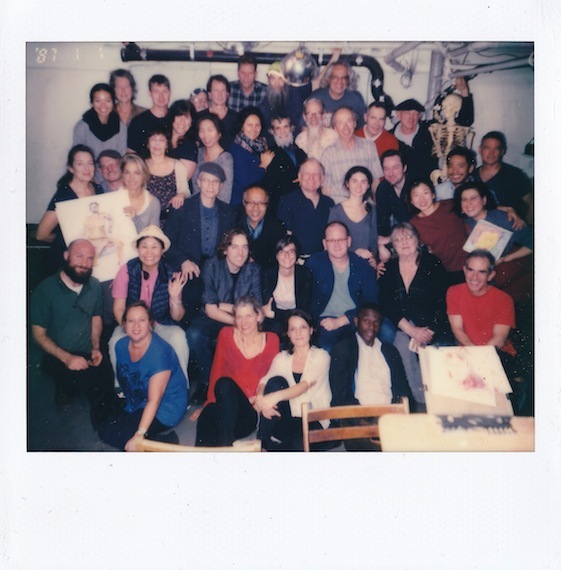
the last session at 64 Spring St., polaroid by Nick McManus
ONLINE: www.springstudiosoho.com ...which should be overhauled any minute now
